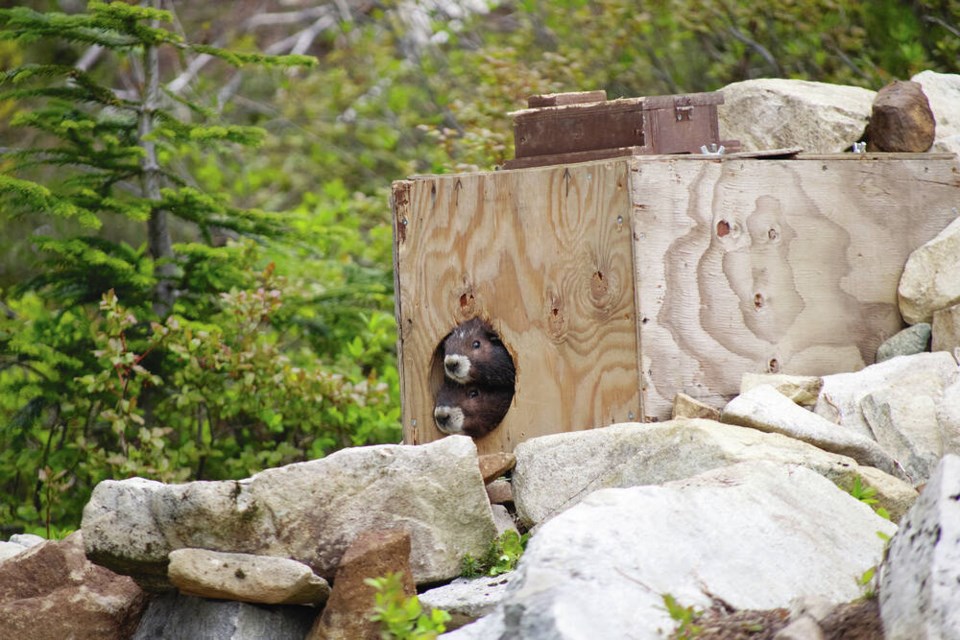Six captive-bred Vancouver Island marmots looked out of their boxes on Mount Washington and took their first steps to a life in the wild last week.
Three males and three females nibbled on vegetation and started exploring their new alpine home.
Big hopes ride on the tiny backs of young marmots like Lenna and Lemar, Zachary and Snowflake and Kendra and Geordi La Forge as researchers try to rebuild the fragile population of one of the world’s most endangered mammals.
And it won’t be easy, said Adam Taylor of the Marmot Recovery Foundation.
The timid rodents face an uphill battle for survival amid food shortages, the swings of climate change and predators.
Potential drought conditions this summer could bring shortages of the plants they rely on while predators such as cougars lurk on the ground and eagles eye them for dinner from above.
“Every year we hope they all make it, but they face a lot of challenges,” Taylor said.
The yearlings are the first of what will be a near record release of about 60 marmots from now until mid-July as captive-breeding programs at Mount Washington and at Toronto and Calgary zoos had a high success rate in reproductive programs over the past year, said Taylor.
At last count in the fall, 303 Vancouver Island marmots were living at 30 sites, most in major colonies in the alpine of either the Nanaimo Lakes region or Strathcona Park.
That’s an improvement from the 200 marmots recorded in 2022, when about 50 animals were lost and there was virtually no reproduction in the wild due to extreme snow packs.
With a reduced snow pack this year, about 40% of what is considered normal in the Strathcona Park, official counts of the wild population and new pups got underway in May but won’t be finalized until the fall. It takes time for volunteers and researchers to study and count the elusive animals.
This year’s release of captive-bred yearlings will be around the Mount Washington area and in colonies on both sides of Buttle Lake in Strathcona Park. Some of the releases in hard-to-access areas will be done via helicopter, with specialists hiking up to meet aircraft full of marmot boxes.
Taylor said the marmots released around Mount Washington have a better survival rate in their first year, usually about 80%, because the presence of human activity such as mountain biking and hiking keeps predators like cougars in check. In more remote locations where predators are less inhibited, survival rates of marmots are down to 40%, he said.
Taylor said marmots have to expend a lot of energy to build dens to live in and a series of tunnels to escape their predators. “Building their infrastructure takes a lot of food,” said Taylor. During drought periods, marmots may have to range further from their dens for nutrition — particularly their favourite, the sugar-laden lupin plant — and those longer trips leave them exposed to predators and possibly under-nourished.
The Island’s unique marmot species hit a low point of fewer than 30 animals in 2003. Breeding programs and habitat-protection projects have helped to bring populations back from the brink of extinction.
In 2013, the population hit a high of 346, but weather and predators, among other factors, took a huge toll. The following year, 266 animals were counted. By 2017, the numbers had dropped again, to 167. Since then, the population has been slowly recovering.
British Columbia’s only endemic mammal is also Canada’s most endangered mammal species. Marmota vancouverensis is considered one of the most endangered mammals in the world. A 2020 study by the International Union for Conservation of Nature put the marmot in a small group of 48 birds and mammals worldwide whose extinctions have probably been prevented by conservation actions.
The recovery effort was initiated in 1997 by a group of partners including the Marmot Recovery Foundation, the province of B.C., the Toronto Zoo, Calgary Zoo, Mount Washington Alpine Resort and timber companies like Mosaic Forest Management.
Those efforts involve captive breeding and re-introductions, translocations, habitat restoration, supplemental feeding and monitoring.
Since 2003, about 600 captive-bred marmots have been released into about 33 sites on the Island.



